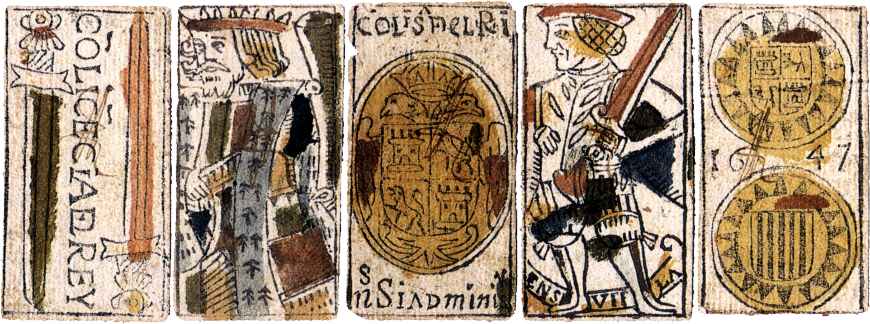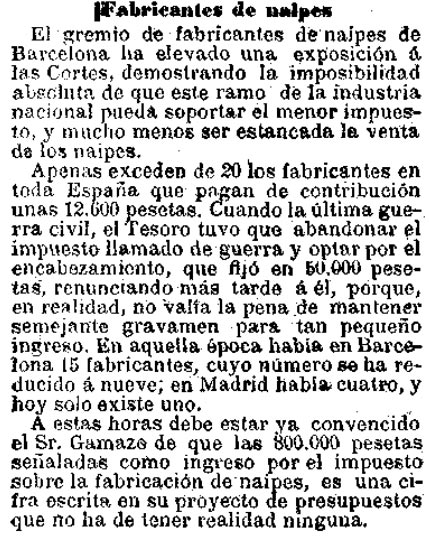Taxation on Spanish Playing Cards
Taxation on Spanish playing cards and the monopolies.
Origins of Taxation on Spanish Playing Cards
The Spanish playing card monopoly was first established in 1543. It was divided into several regions including Aragon, Toledo, Castile, Seville as well as Mexico and ‘New Spain’. Leases for these respective monopolies were awarded on a competitive basis to the highest bidder and subject to strict controls. Lease holders also enjoyed the protection of laws governing the playing card monopolies, which included the outlawing of contraband playing cards and protection against Moors, Turks, Pirates, Corsairs and enemies of the Catholic Faith. Manufacturers were required to sell their packs of playing cards at prices controlled by law. Whilst the different regional monopolies were subject to different fiscal and administrative regimes, it is not clear whether any regional differences existed in the style or design of the playing cards themselves.
Catalonia had a local tax in the 17th century, at least since 1613. The assignment of the lease on May 8, 1628, also involved cards imported from France, but more from Castile. Card makers registered samples of their production. For export, cards and packaging had to be marked.
Until the 19th century, there were forms of monopoly on making and selling cards. The last one was the Real Fábrica de Naipes, the Royal Card Factory of Madrid (18th century - beginning of the 19th century). Its marking "RL FB DE MD" can be read on some packs. Imitations, e.g., made in Turnhout, had the spelling "RL EA DE MD".
Sevilla, XVII Century

Above: Spanish playing cards, woodcut & stencil, Seville, dated 1638 on the Ace of Cups. The Ace of Batons and the Two of Cups have small naked figures adorning the suit symbols. The Ace of Coins has a two-headed imperial eagle. Inscriptions on the cards read: "En S (en Sevilla) Con Licencia del Rey." These cards were discovered inside a wall during the demolishing of the former Granada prison, and were probably handled by gambling card players running a racket inside jail. Image of cards in the Fournier Museum, Alava, taken from: Agudo Ruiz: Los Naipes en España, Diputación Foral de Álava, 2000.
Revenues from the Seville playing card monopoly, which also included Granada and the Canary Isles, reached twelve million maravedis when it was acquired by Francisco de Zayas for a ten year tenure. Cards made in Seville during this period have official signatures on certain cards as proof of taxes paid to the treasury.

Above: Spanish playing cards, woodcut & stencil, made in Seville, dated 1647 on the Two of Coins. Official signatures on certain cards were proof that taxes had been paid to the treasury. Image of cards in the Fournier Museum taken from: Agudo Ruiz: Los Naipes en España, Diputación Foral de Álava, 2000.

Above: Spanish playing cards, woodcut & stencil, made in Seville, late XVII centiry. Several cards bear legends relating to the royal licence for the administration of the sale of playing cards. Two Sotas also have banderoles with the text 'En Sevilla'. Image of cards in the Fournier Museum taken from: Agudo Ruiz: Los Naipes en España, Diputación Foral de Álava, 2000.
Seville was a favoured location by gamblers read more →

References: Agudo Ruiz, Juan de Dios: Los Naipes en España, Diputación Foral de Álava, 2000
See also: Gothic Spanish-suited cards • Phelippe Ayet/Jean Pouns • Navarra 17th Century • The Spanish National pattern • The Money Bag pattern • Rotxotxo Workshop Inventories, Barcelona • Real Fábrica de Macharaviaya • José Gombau, 1833 • Sanmarti, 1840 • Maciá Pattern • José Martinez de Castro (Madrid) • Fournier Hermanos (Burgos) 1860 • Heraclio Fournier S.A. (Vitoria) • Baraja de Amor, Hijos de Taboadela, 1871 • Hija de B. Fournier (Burgos) • Ibero-American Deck • Antonio Moliner (Burgos) 1890 • French Catalan pattern • S. Giráldez (Barcelona) c.1910 • Simeon Durá (Valencia) • Belgian Spanish Cards • República Española Souvenir • Vic Joc de Cartes, 1990

By Simon Wintle
Member since February 01, 1996
Founder and editor of the World of Playing Cards since 1996. He is a former committee member of the IPCS and was graphics editor of The Playing-Card journal for many years. He has lived at various times in Chile, England and Wales and is currently living in Extremadura, Spain. Simon's first limited edition pack of playing cards was a replica of a seventeenth century traditional English pack, which he produced from woodblocks and stencils.
Related Articles

Braulio Fournier
Baraja Nº 1 produced by Braulio Fournier, Burgos, c.1868.

Pirritx eta Porrotx
Happy Families card game from the Spanish Basque Country.

Naipe Vizcaino
‘Naipe Vizcaino’ designed by Javier Urkiri and published by Industrias Gráficas Castuera and the Caj...

Spanish pattern by Eugène Boisse
Spanish pattern published by Eugène Boisse, Bordeaux.

Baraja Turística del País Vasco
Basque poker deck of 55 cards published by Fournier with scenic views of the Basque Country.

Baraja Vasca
Spanish Basque Country deck with original drawings by María Isabel Ibañez de Sendadiano.

Baraja Cultura Española
ASESCOIN pack for 2022 designed by M.A. Corella featuring famous Spaniards and notable buildings.

Laurenzo Propagine
Spanish-suited cards made in Italy by Laurenzo Propagine.

Jeu de 7 familles Les Dynasties d’Artisans Basques
Long-standing Basque businesses represented in a traditional card game with illustrations by Odile A...

Archaic Franco-Spanish pattern
Archaic Franco-Spanish pattern by Guillaume & Jean Grossard (Bordeaux).

La Baraja del Mundial
“La Baraja del Mundial” satirical football deck published by Fournier for ‘Interviú’ news magazine. ...

Archaic Spanish proof sheets
2 x uncoloured proof sheets of archaic Spanish-suited playing cards produced for “New Spain”, possib...

Hispania Romana
Educational card game depicting the Roman period in Spanish history.

QAIPES – cartas españolas
Spanish-suited cards made in China inscribed “QAIPES” and “BAIPES”!

Baraja de la Cocina Española
A celebration of Spanish gastronomy, with designs by Silja Götz employing non-standard suits.

Moguls, Highlanders and Merry Andrews
Discover the historic origins and evolution of card naming and quality designations like ‘Moguls’ an...
Trending Articles
Popular articles from the past 28 days


